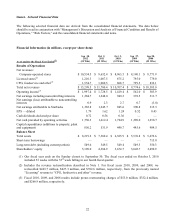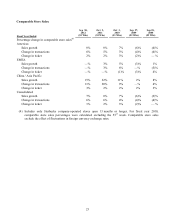Starbucks 2012 Annual Report Download - page 34
Download and view the complete annual report
Please find page 34 of the 2012 Starbucks annual report below. You can navigate through the pages in the report by either clicking on the pages listed below, or by using the keyword search tool below to find specific information within the annual report.
28
incremental revenues from net new company-operated store openings over the past 12 months (approximately
$184 million).
Licensed store revenues contributed $203 million to the increase in total net revenues in fiscal 2012, primarily due
to higher product sales to and royalty revenues from our licensees, resulting from improved comparable store sales
and the opening of 665 net new licensed stores over the past 12 months.
CPG, foodservice and other revenues increased $494 million, primarily due to sales of Starbucks and Tazo
branded K-Cup®portion packs launched in the CPG channel on November 1, 2011 (approximately $232 million).
The benefit of recognizing full revenue from packaged coffee and tea under the direct distribution model
(approximately $78 million) and an increase in foodservice revenues (approximately $50 million) also
contributed.
Operating Expenses
Fiscal Year Ended
Sep 30,
2012
Oct 2,
2011
Sep 30,
2012
Oct 2,
2011
% of Total
Net Revenues
Cost of sales including occupancy costs $ 5,813.3 $ 4,915.5 43.7% 42.0%
Store operating expenses 3,918.1 3,594.9 29.5% 30.7%
Other operating expenses 429.9 392.8 3.2% 3.4%
Depreciation and amortization expenses 550.3 523.3 4.1% 4.5%
General and administrative expenses 801.2 749.3 6.0% 6.4%
Total operating expenses 11,512.8 10,175.8 86.6% 87.0%
Gain on sale of properties
—
30.2 — 0.3%
Income from equity investees 210.7 173.7 1.6% 1.5%
Operating income $ 1,997.4 $ 1,728.5 15.0% 14.8%
Supplemental ratios as a % of related revenues:
Store operating expenses 37.2% 37.3%
Cost of sales including occupancy costs as a percentage of total net revenues increased 170 basis points, driven by
increased commodity costs (approximately 160 basis points), primarily due to higher coffee costs.
Store operating expenses as a percentage of total net revenues decreased 120 basis points, due to increased
Channel Development and licensed store revenues. Store operating expenses as a percent of company-operated
store revenues decreased 10 basis points due to increased sales leverage.
Other operating expenses as a percentage of total net revenues decreased 20 basis points. As a percentage of net
revenues excluding company-operated store revenues, other operating expenses decreased 350 basis points. This
decrease was primarily driven by increased sales leverage (approximately 150 basis points), the absence of
charges in fiscal 2012 related to the Seattle’s Best Coffee store closures in Borders bookstores (approximately 80
basis points) and a shift in the timing of marketing spend (approximately 60 basis points).
Income from equity investees increased $37.0 million, primarily due to an increase in income from our North
American Coffee Partnership (approximately $13 million), Japan (approximately $11 million) and Shanghai
(approximately $10 million) joint venture operations.
The combination of these changes, along with increased sales leverage on depreciation and amortization
(approximately 40 basis points) and general and administrative expenses (approximately 40 basis points), resulted
in an increase in operating margin of 20 basis points over fiscal 2011.
%
























